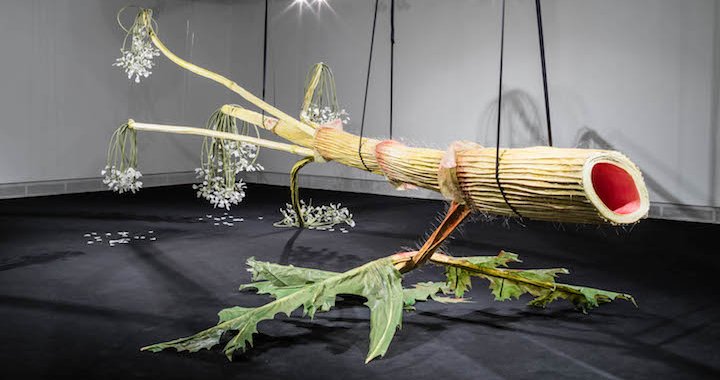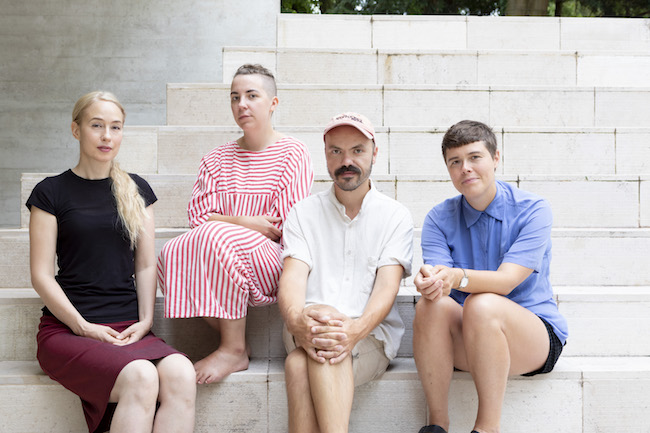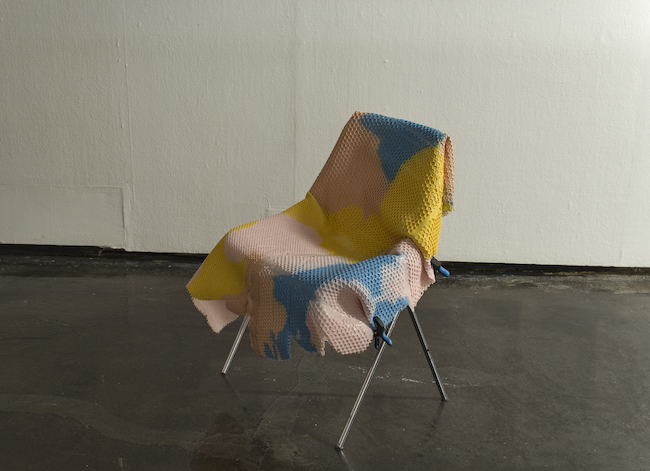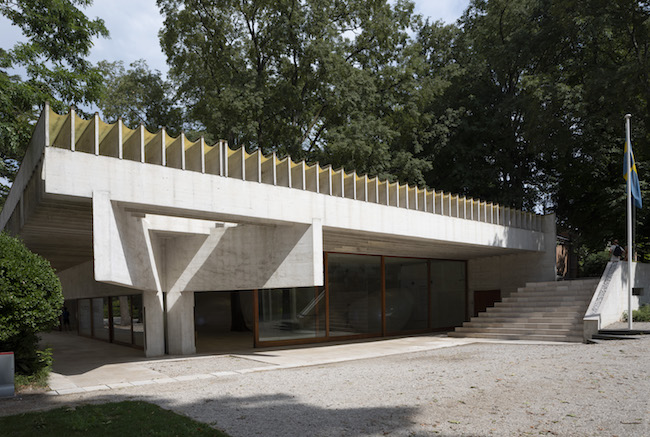
Nordic Report: La Biennale 2019
An express-interview with Piia Oksanen and Leevi Haapala, the curators for the Nordic Pavilion at the 58th International Art Exhibition of La Biennale di Venezia
29/10/2018
Although the story of the International Art Exhibition of La Biennale di Venezia began nearly 125 years ago, when signor Riccardo Selvatico came up with the idea for the biennial, it was only by the 1950s when the Nordic countries got to have their own national pavilion. After an almost two-year-long exchange of letters between Rodolfo Pallucchini and chairman of the Swedish committee Erik Wettergren, other proposals and complications, four architects from Finland, Sweden and Norway were finally invited to submit their innovative projects. Norwegian architect Sverre Fehn introduced a project of “stunning simplicity” that later became a characteristic example for Northern design and architecture. This so-called “stunning simplicity” in combination with deeply intellectual and exploratory context could be labelled the essence of the Nordic culture.
Since 1962, the pavilion has welcomed 27 different exhibitions and more than 100 artists, including the famous American “dilettante” Mark Dion (in 1997), the experimental storyteller Eija-Liisa Ahtila (in 1999) and the powerful German photographer Wolfgang Tillmans (in 2009). Last time, for the 57th Biennale, curator Mats Stjernstedt proposed an exhibition “Mirrored” – an attempt to present a mapping of connections that would overcome some stereotypical national and regional boundaries. A group of six artists from different generations (Siri Aurdal, Nina Canell, Charlotte Johannesson, Jumana Manna, Pasi Myllymäki and Mika Taanila) tracked and mirrored an artistic practice of a possible connection.
For the 58th edition of La Biennale di Venezia, curators Leevi Haapala and Piia Oksanen have chosen another simple yet important subject dealing with global issues. The concept of exhibition Weather Report: Forecasting Future focuses on the complex and varied relations between humans and other living organisms in an age when climate change and mass extinction are undermining the preconditions of life on Earth. This composite truth will be represented by four perspective artists Ane Graff from Norway, Ingela Ihrman from Sweden, Janne Nabb and Maria Teeri from Finland.

Piia Oksanen and Leevi Haapala. Photo: Pirje Mykkänen
The Nordic Pavilion at the 58th International Art Exhibition of La Biennale di Venezia is going to be dedicated to the theme of global issues. What is the curatorial intention behind this choice?
Leevi Haapala: Earlier this year, when Kiasma took the responsibility of the Nordic Pavilion for the 2019 edition, we decided to focus on the main global concern of our time. The exhibition Weather Report: Forecasting Future is dedicated tothe complex and varied relations between humans and other living organisms in an age when climate change and mass extinction are undermining the preconditions of life on Earth. Now that the Intergovernmental Panel on Climate Change published their special report on the impacts of global warming of +1,5∞C earlier this week, the timing of our topic could not be more urgent. And we know that many artists share this same concern and have their word to say on this issue.
Piia Oksanen: Ecological questions are obviously urgent ones. We decided to concentrate on human and non-human relations and wish to think about possibilities for re-negotiating the relationship between species, to be in solidarity with the non-human.
.jpg)
Ane Graff. Untitled, 2018 (detail)
It is true that certain human actions have significantly changed the environment and climate of this planet. Do you believe that art is a possibility to examine these human activities and lead society to a way of better understanding of climate issues?
P. O.: Art can definitely be one way of approaching these questions. We invited the artists to reflect on future. I think we need multiple perspectives to think about time to come; we must not leave it only to scientists and politicians to reflect and plan. Art is one way of critical thinking, but also of producing knowledge that can involve insecurities, pose questions without offering new fixed categories.
L. H.: We often want to foresee events whose level of predictability is particularly low, such as fluctuations of the economy and outcomes of political campaigns, as well as forecasts of climate warming. As humans, we need forecasts to feel safe. In art, however, the future is forecast differently. For centuries and decades, artists have looked ahead to create environmental, technological and political utopias and dystopias, some of which have become a reality – whether we wanted to or not. Accepting uncertainty, future scenarios and the potential contained in future change and processuality, these are all part of the horizon of assumptions in contemporary art. The production of new information and new experiences of the world – which also involves affective elements and thereby, potentially also for identification, visual interest and utilisation of a variety of technologies ‒ all this invites us to reappraise and re-contextualise ideas about the climate.
The exhibition “Weather Report: Forecasting Future” will be presented by four Nordic artists: Finnish artist duo nabbteeri (Janne Nabb and Maria Teeri), Ane Graff form Norway and Ingela Ihrman from Sweden. How were these artists selected?
L. H.: Piia and I both listed our own candidates, artists for whom environmental issues have been relevant during the past years. We also asked for proposals from the Nordic Committee members, namely the co-commissioners of the Nordic Pavilion, which are Moderna Museet’s co-director Ann-Sofi Noring and Office for Contemporary Art Norway’s (OCA) director Katya García-Antón. They and their curator colleagues named some potential artists for us to meet. After the first selection round we made our research trip to Stockholm and Malmö in Sweden and Oslo and Tromsø in Norway to meet the shortlisted artists in person. During the spring we met with some five artists from each country. After that we drafted three different exhibition concepts in order to wrap up what we had learned during this intense research period and then consider how to make the best selection out of it conceptually, spatially, and decide who were those artists we would like to promote on this occasion. Now we are really confident with the selected artists. Last August we made a study trip together with the artists to Venice which helped us all to get to know each other better, have our first impressions of the site and also to sketch some first ideas for the exhibition.

Artists for the Nordic Pavillion in Venice 2019. Ane Graff, Maria Teeri, Janne Nabb, Ingela Ihrman. Photo: Pirje Mykkänen
What is it that unites these artists?
P. O.: In the Nordic Pavilion we wish to give space for interspecies relations, for human and non-human entanglements and look at the vulnerability of these relations. This is something that all these artists share. nabbteeri pay attention to the species co-existing with us. In her works Ane Graff makes visible the ways in which the human body is exposed to other agencies, such as bacteria. Ihrman observes the human perspective to the non-human, e.g. discussing the definition of “invasive species”, questions of belonging. Collectivity is also somehow present in all of their practice: they work in a collective (nabbteeri), collaborate with researchers (Graff) or organize events of sharing (Ihrman). One core question is how to live together.
L. H.: Selected artists share multidisciplinary approach, all of them combine different points of view, from visual arts to humanities and natural sciences. Ane Graff uses a broad range of research disciplines, from feminist new materialism to microbiology and chemistry.Ingela Ihrman comments on the 1970s wave of environmental consciousness but also has input from the queer studies and ethnobiology perspectives. Artist duo nabbteeri work with context-specific way by mapping the place where they are working. Their work develops in interaction with the environment, its materiality and its multi-species inhabitants. During the site visit we found out, that they have also mutual interests like low-carbon transport, gardening and healthy life habits.

Nabbteeri. Thinking of Invertebrates, 2018
Is the visitor of this exhibition going to be predominantly captivated by the intellectual content or is it going to be a visually satiated adventure as well?
P. O.: It is definitely both. We are asking urgent questions, and the artists work collaboratively, reaching out to other disciplines. But because the questions of how humans are connected to the non-human are very material, the works will be tangible and the experience will be bodily.
L. H.: The Nordic Pavilion is the most beautiful pavilion in the Giardini. We want to highlight the openness of the space of the Pavilion, and our aim is to make it also a visually tempting and inviting place to visit. In that way we also hope that visitors will be more open to ponder these ecological questions the artists are providing. So, there will definitely be several layers: from aesthetic attractions to thought-provoking questions about human and non-human coexistence and also the wellbeing on this planet.

Photo: Pirje Mykkänen
How do you understand the central title of La Biennale di Venezia – May You Live in Interesting Times? And how does it interact with the theme of the Nordic Pavilion?
P. O.: From the perspective of our project I could think about it as curiosity towards the unknown, with a sense of solidarity and openness, maybe also a will to give up something, to let go in order to learn new ways of producing knowledge, of sharing the space.
L. H.: This ancient Chinese curse, selected by the curator of the Venice Biennale Ralph Rugoff as a motto for the main exhibition, resonates perfectly with our theme for the Nordic Pavilion. With our exhibition, we would like to promote hope and optimism towards the unknown future and encourage people to understand that the future is still in our own hands. We should be able to care about the future, especially in the Nordic countries where we have high standards of living, a close relationship with and access to nature and new technological solutions. It makes it our responsibility to raise these questions and to bring new ideas into the discussion. Artists do it in on their own affective, intuitive and unpredictable ways. We are definitely living in interesting times!
.jpg)
Photo: Pirje Mykkänen